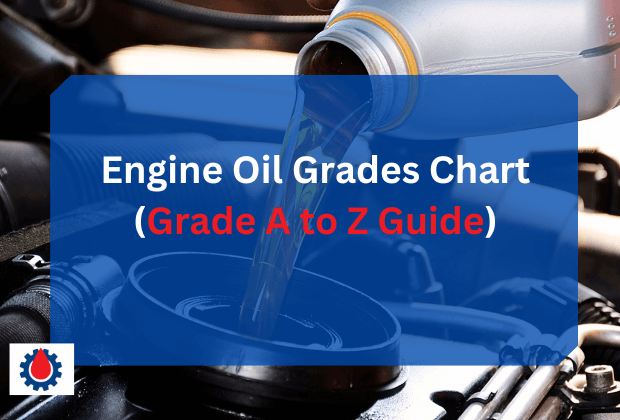Engine oil plays a crucial role in the performance and longevity of a vehicle’s engine. It lubricates moving parts, reduces friction, prevents overheating, and protects against wear and tear.
Selecting the right engine oil can be confusing due to the variety of grades available. This post guide will explain engine oil grades, their meanings, and how to choose the best one for your vehicle.
Engine Oil Grades Chart
| SAE Grade | Cold Temperature Performance | High Temperature Performance | Best For |
|---|---|---|---|
| 0W-16 | Excellent for extremely cold climates | Thin at high temperatures, fuel-efficient | Hybrid & modern small engines |
| 0W-20 | Great cold start protection | Reduces friction, improves fuel economy | Newer gasoline engines |
| 5W-20 | Good cold weather flow | Suitable for warm climates, enhances efficiency | Modern fuel-efficient cars |
| 5W-30 | Works well in most temperatures | Provides balanced protection | Most passenger vehicles |
| 10W-30 | Moderate cold-weather performance | Slightly thicker, better for older engines | Older vehicles & moderate climates |
| 10W-40 | Moderate cold-weather flow | Ideal for high-mileage engines | Older, high-performance cars |
| 15W-40 | Performs well in mild winter | Heavy-duty engine protection | Diesel trucks & commercial vehicles |
| 20W-50 | Thicker, not suitable for cold weather | High protection for hot climates | Classic cars & high-performance engines |
Read Engine Oil Thickness Chart(A to Z Guide)
What Are Engine Oil Grades?
Engine oil grades indicate the viscosity of the oil, which determines how well it flows at different temperatures. These grades are classified by the Society of Automotive Engineers (SAE) using numbers and letters such as 5W-30, 10W-40, or 15W-50.
Breaking Down the SAE Oil Grade Format
Each engine oil grade consists of two numbers separated by the letter ‘W’, which stands for Winter.
For example, in 5W-30:
- 5W – The first number indicates the oil’s viscosity in cold temperatures. A lower number means better flow in cold weather.
- 30 – The second number shows the viscosity at high temperatures (100°C). A higher number means thicker oil at high temperatures, offering better protection.
Read Engine Oil Temperature Chart(Complete Guide)
How to Choose the Right Engine Oil for Your Vehicle
1. Check the Owner’s Manual
Your vehicle manufacturer provides recommended oil grades based on the engine’s requirements. Always refer to the owner’s manual before choosing an oil.
2. Consider the Climate
- If you live in cold regions, opt for 0W or 5W oils for better cold start performance.
- If you drive in hot climates, use higher viscosity grades like 10W-40 or 20W-50 for better engine protection.
3. Understand Your Driving Conditions
- For city driving with frequent stops – Choose lower viscosity oil (0W-20 or 5W-30) to improve fuel efficiency.
- For towing or heavy-duty use – Opt for thicker oils (15W-40 or 20W-50) for better engine durability.
4. Consider the Engine Type
- For new or hybrid engines – Use low-viscosity synthetic oils like 0W-16 or 0W-20.
- For high-mileage engines – Thicker oils like 10W-40 or 20W-50 can reduce leaks and wear.
Read Car Engine Oil Color Chart(Color That Signals Immediate Danger)
Types of Engine Oil Based on Formulation
Besides viscosity grades, engine oils also vary based on their formulation:
1. Conventional Oil
- Derived from crude oil with basic additives.
- Suitable for older vehicles and light-duty engines.
2. Synthetic Oil
- Engineered for superior performance and longevity.
- Provides better protection in extreme temperatures.
- Ideal for modern engines and high-performance vehicles.
3. Synthetic Blend Oil
- A mix of conventional and synthetic oil.
- Offers better performance than conventional oil at a lower cost than full synthetic.
4. High-Mileage Oil
- Formulated with additives to reduce leaks and oil burn-off.
- Designed for vehicles with 75,000+ miles.
Read Engine Oil Capacity Chart(Guide Model A to Z)
FAQs
What are the grades of engine oil?
Engine oil grades are classified by the Society of Automotive Engineers (SAE) based on their viscosity at different temperatures. Some common grades include:
- Multi-grade oils: 0W-20, 5W-30, 10W-40, 15W-50, etc. (suitable for different climates and conditions).
- Single-grade oils: SAE 30, SAE 40, SAE 50 (used in specific applications like classic cars or small engines).
Which oil is thicker, 5W30 or 10W30?
10W-30 is thicker than 5W-30 at cold temperatures, but both have the same viscosity at high temperatures (100°C).
- 5W-30 flows better in cold weather, making it ideal for winter.
- 10W-30 is slightly thicker in cold temperatures, which may be better for older engines.
Read Does Engine Oil Have A Use By Date(how long does oil last)
Which oil is thicker, SAE 30 or SAE 40?
SAE 40 is thicker than SAE 30 at high temperatures.
- SAE 30 is commonly used in smaller engines, like lawnmowers.
- SAE 40 is preferred for hotter climates or high-performance engines that need thicker oil for protection.
What grade oil is best for older engines?
Older engines often benefit from thicker oils because they help seal worn-out engine components and reduce leaks. Some good options include:
- 10W-40 (suitable for moderate climates).
- 15W-40 (great for high-mileage or heavy-duty vehicles).
- 20W-50 (best for classic or high-performance cars).
- High-mileage synthetic oils are also recommended for engines with 75,000+ miles.
What is the best engine oil grade?
The best engine oil grade depends on the vehicle, climate, and driving conditions.
- For modern cars: 0W-20 or 5W-30 for fuel efficiency and protection.
- For older vehicles: 10W-40 or 15W-40 for better lubrication.
- For performance engines: 20W-50 provides added protection in high temperatures.
Read Oil Drain Plug Torque Chart(Vehicles A to Z)
What are the SAE grades of oil?
SAE grades include:
- Single-grade oils: SAE 10, SAE 20, SAE 30, SAE 40, SAE 50.
- Multi-grade oils: 0W-16, 0W-20, 5W-20, 5W-30, 10W-30, 10W-40, 15W-40, 20W-50.
- Multi-grade oils are the most common in modern vehicles because they offer better performance in a range of temperatures.
What is the best oil for a car engine?
The best oil for your car engine depends on your vehicle’s requirements.
- For new cars: Full synthetic oils (0W-20, 5W-30) are recommended.
- For older engines: High-mileage oils (10W-40, 15W-40, or 20W-50) work best.
- For high-performance or racing cars: Thicker oils (10W-60, 20W-50) provide better protection.
Read Engine Oil Additives to Stop Ticking Lifter(Top 5 Best Oil)
Final word
Choosing the right engine oil is essential for your vehicle’s health and longevity. By selecting the correct viscosity based on climate, driving conditions, and engine type, you can ensure optimal engine performance and protection.




